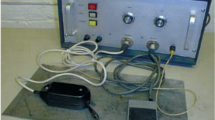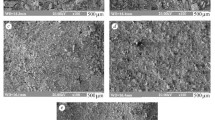Conclusions
Solid solutions and the eutectic in the alloying electrode decrease its erosion during ESA, while the intermetallic compound and other brittle phases increase it. The erosion resistance of the anode grows with decrease in its porosity, and shows a correlation with the variation of its strength. A sufficiently strong bond between the phases in the heterophase material increases the latter's erosion resistance and leads to the formation of erosion products of mainly fine fractions. The presence in the anode of phases which can form iron-base solid solutions or intermetallic compounds with the basis material has a beneficial effect on the cathode weight gain. Phases which do not have this ability are retained on the cathode only when they have a strong bond with a phase (e.g., the metallic binder) which itself can form both solid solutions and intermetallic compounds with the basis.
Similar content being viewed by others
Literature cited
G. V. Samsonov, A. D. Verkhoturov, G. A. Bovkun, and V. S. Sychev, Electric-Spark Alloying of Metallic Surfaces [in Russian], Naukova Dumka, Kiev (1976).
A. D. Verkhoturov and I. M. Mukha, Technology of Electric-Spark Alloying of Metallic Surfaces [in Russian], Tekhnika, Kiev (1982).
P. S. Kislyi, M. A. Kuzenkova, and B. D. Storozh, “Production, properties, and fields of application of titanium nitride base cermets and composite materials,” in: Powder Metallurgy [in Russian], Riga (1975), pp. 23–28.
F. F. Egorov, P. S. Kislyi, and P. A. Verkhovodov, “Strength of composite materials,” Poroshk. Metall., No. 8, 22–26 (1979).
F. F. Egorov, P. S. Kislyi, and P. A. Verkhovodov, “Strength of sintered Mo-Al2O3 and Mo-ZrN composite materials,” Poroshk. Metall., No. 1, 58–63 (1980).
A. D. Verkhoturov and O. A. Medvedeva, “Use of boride-carbide alloys for the electric-spark strengthening of steels,” Elektron. Obrab. Mater., No. 5, 34–36 (1973).
G. V. Samsonov, I. M. Mukha, and L. V. Globa, “Theory and technique of manufacture of electrode-tool materials for electroerosion machining,” Poroshk. Metall., No. 1, 71–75 (1970).
A. D. Verkhoturov, “Investigation of electrode materials for electric-spark alloying and their principles of manufacture,” Preprint No. 5, Inst. Probl. Materialoved., Akad. Nauk Ukr. SSR, Kiev (1980).
Author information
Authors and Affiliations
Additional information
Translated from Poroshkovaya Metallurgiya, No. 4(268), pp. 32–36, April, 1985.
Rights and permissions
About this article
Cite this article
Egorov, F.F., Poveshchenko, V.I. & Verkhoturov, A.D. Effect of phase composition and microstructure of sintered TiN-Cr electrode material on the main characteristics of the process of electric-spark alloying of steels. Powder Metall Met Ceram 24, 286–290 (1985). https://doi.org/10.1007/BF00805223
Received:
Issue Date:
DOI: https://doi.org/10.1007/BF00805223




